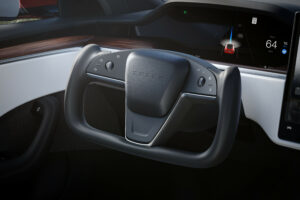
Tesla Autopilot under further scrutiny, over 2M vehicles recalled
By onTechnology
Tesla has recalled more than 2.03 million of its Model S, 3, X, Y, and Z vehicles of varying model years over its advanced driver assistance system (ADAS) “Autopilot” and “Autosteer” as the result of a National Highway Traffic Safety Administration (NHTSA) investigation.
Autopilot is defined by Tesla as “a suite of advanced driver assistance features that are intended to make driving safer and less stressful,” and doesn’t make its vehicles fully autonomous or replace the driver, meaning it’s an SAE Level 2 ADAS feature. It includes Traffic-Aware Cruise Control, which maintains the vehicle’s speed and, if there is a vehicle ahead, an adjustable following distance.
Autopilot features come standard with all new Tesla vehicles.
According to Tesla, Autosteer is a beta feature, i.e., a prototype still being tested, and “maintains a set speed (if there is not a vehicle in front of you) or a set following distance (if there is a vehicle in front of you)… detects lane markings, road edges, and the presence of vehicles and objects to intelligently” keep Autosteer-equipped vehicles in the appropriate driving lane.
The vehicle recall population was produced between Oct. 5, 2012 and Dec. 7, 2023 and includes all of the following models that are equipped with Autosteer:
-
- 2012-2023 Model S
- 2017-2023 Model 3
- 2016-2023 Model X
- 2020-2023 Model Y
The recall stems from a National Highway Traffic Safety Administration (NHTSA) investigation that began in August 2021 following crashes with stationary first-responder vehicles and Tesla vehicles that were operating with Autosteer engaged.
Since then, several crashes involving the feature, as well as Tesla’s “Full Self-Driving (FSD),” have allegedly caused injuries and deaths. A separate recall issued by Tesla earlier this year involved all vehicles equipped with FSD.
There have also been lawsuits filed over the technology, one of which Tesla won in court last month. A jury determined Autopilot wasn’t responsible for the crash at issue that killed one person and injured two others.
According to NHTSA’s recall report, between Oct. 16 and Dec. 4 of this year, NHTSA met with Tesla concerning its tentative conclusions that the issue has been caused by “potential driver misuse when Autosteer is engaged.”
“In certain circumstances when Autosteer is engaged, and the driver does not maintain responsibility for vehicle operation and is unprepared to intervene as necessary or fails to recognize when Autosteer is canceled or not engaged, there may be an increased risk of a crash,” the recall report states.
NHTSA wanted its concerns addressed through a voluntary recall by Tesla. Tesla issued the recall on Dec. 5 and said an over-the-air (OTA) software update will be sent out that would fix the problem.
NHTSA noted that Tesla has cooperated with the administration’s requests for information and meetings over the past nearly two-and-a-half years. However, NHTSA wrote that Tesla didn’t agree with the agency’s investigation.
“Specifically, the investigation found that Tesla’s unique design of its Autopilot system can provide inadequate driver engagement and usage controls that can lead to foreseeable misuse of the system,” an NHTSA spokesperson told Repairer Driven News on Wednesday. “In its Defect Information Report, Tesla stated that Autopilot’s software system controls ‘may not be sufficient to prevent driver misuse.’
“Based on NHTSA’s investigation, Tesla initiated the recall to address this safety defect. NHTSA’s investigation remains open as we monitor the efficacy of Tesla’s remedies and continue to work with the automaker to ensure the highest level of safety. Automated technology holds great promise for improving safety but only when it is deployed responsibly; today’s action is an example of improving automated systems by prioritizing safety.”
NHTSA said its Standing General Order that mandates reporting of certain types of crashes involving automated driving system (ADS)- or SAE ADAS Level 2-equipped vehicles “has already provided a wealth of additional information for investigators” and Tesla’s Dec. 5 recall is “the result of NHTSA’s thorough investigative work.”
The SGO was first issued in June 2021 and was updated in April 2023. OEMs must report ADS vehicle crashes if the system is used within 30 seconds of a crash and involves property damage or injury. The same reporting timeframe is required for Level 2 ADAS vehicles but the crash must also involve a vulnerable road user (such as a pedestrian, motorcyclist or bicyclist), or result in a fatality, vehicle tow-away, an air bag deployment, or anyone being taken to a hospital for medical treatment.
“Through the Standing General Order, NHTSA has more information than ever before, allowing the agency to quickly identify and thoroughly investigate crash trends and safety risks,” the NHTSA spokesperson said. “As part of this investigation, NHTSA reviewed 956 crashes where Autopilot was initially alleged to have been in use, then focused on a narrower set of 322 Autopilot-involved crashes, including frontal impacts and impacts from potential inadvertent disengagement of the system. Throughout this ongoing investigation, NHTSA engaged a multi-disciplinary team comprising its enforcement, research, and data offices. This team included experts in the fields of human factors, electronics engineering, advanced driver assistance systems, [and] legal and statistical analyses.
“Safety recalls serve a vital purpose by protecting the traveling public from safety defects. The Vehicle Safety Act requires manufacturers to conduct a recall for any repair, including a software update, that remedies an unreasonable risk to safety.”
Tesla said it would begin sending out the OTA update on Dec. 7. Model S, Model X, Model 3, and Model Y vehicles in production at the time of the recall notice received a software release that incorporated the software remedy.
Images
Featured image: Tesla Model S interior (Provided by Tesla)
